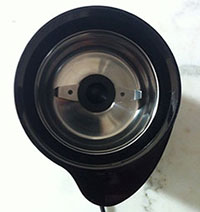Grinding your freshly roasted coffee beans prior to brewing is a crucial step to coffee perfection. Those lacking the mysterious and closely guarded knowledge of using a coffee mill simply load it halfheartedly with coffee beans and let it rip without any concern for particle size and consistency. Well, it’s time to put an end to that!
In this article I’ll lay out the pros and cons of using an electric blade grinder and give you our technique for using it properly.
Coffee Mills
Sometimes also referred to as electric blade grinders, whirly grinders, or propeller grinders) chop up coffee beans into smaller particles as opposed to grinding them. They do this via propeller shaped stainless-steel blades revolving at very high speed (20,000 – 30,000 rpm).
You control the fineness of the coffee grind by how long you let the blades chop up the beans. In theory, the longer you run it, the smaller the particle size.
Since it’s operated manually, and hence has no settings for grinds, you do need to be familiar with what different grinds look like. Know your appropriate grind size for your brewing method and you’ll know when to stop grinding the coffee.
A Look at the Benefits
1) Inexpensive
Blade grinders are inexpensive, ranging anywhere from EGP 200 to EGP 1000 in price. This certainly is attractive when you compare them to decent burr grinders, which can range anywhere from EGP 3000 to EGP 7000 for home use.
2) Small Footprint
A further benefit is its size. The footprint is fairly small so they are ideal for a cramped kitchen or for people who like to take their grinder with them when they travel.
3) Enjoy Flavored Coffees Without Guilt
A blade grinder might be a good choice if you enjoy flavored coffees. Grinding flavored coffee beans will impart an off-taste to any other coffee that is ground in the same grinder. That’s why you often see two grinders in supermarkets; one for unflavored coffee beans and one for flavored ones. Since these simple machines are very easy to clean, this doesn’t pose much of a problem.
Four Major Drawbacks
1) Uneven Particle Size
Ideally the grind particles should all be uniform in size and shape. The trouble with blade grinders is that they produce grinds that are inconsistent in shape and size. You get a mix of ground coffee ranging from coarse to fine, with a healthy dose of dusty particles. This is because the blade grinder doesn’t actually “grind” the beans, but rather slices, shaves and pulverizes them indiscriminately.
Inconsistent grinds that vary in size and shape extract unevenly and unequally. This is going to cause the coffee to extract unevenly and result in an unbalanced, bitter brew. And if that isn’t bad enough, you might have to put up with “coffee dust” in your cup of coffee.
2) Grind is heated
It’s easy to burn the coffee with a blade grinder due to the friction caused by the blades rotating at a very high speed. The longer you grind the beans without pausing, the more heat is created by the blades. This could give your coffee a burned and more bitter flavor.
3) No consistency
It’s almost impossible to achieve a proper grind consistently. Sure, it’s possible to get a grind with minor inconsistencies once in a while. However, replicating that is nearly impossible. There are simply too many factors that you can’t control. So trusting your precious beans to the workings of the blade grinder becomes a hit or miss scenario.
4) Static charge
Because of the high speed of the blades the grind picks up a static charge. This causes some grind particles to jump out of the reservoir and stick to everything they come into contact with. As you can imagine this ghoulish and spine-chilling phenomenon can be fairly messy and is not something I want to experience first thing in the morning.
Grinding your freshly roasted coffee beans prior to brewing is a crucial step to coffee perfection. Those lacking the mysterious and closely guarded knowledge of using a coffee mill simply load it halfheartedly with coffee beans and let it rip without any concern for particle size and consistency. Well, it’s time to put an end to that!
In this article I’ll lay out the pros and cons of using an electric blade grinder and give you my technique for using it properly.
The Introduction
 Coffee mills (sometimes also referred to as electric blade grinders, whirly grinders, or propeller grinders) chop up coffee beans into smaller particles as opposed to grinding them. They do this via propeller shaped stainless-steel blades revolving at very high speed (20,000 – 30,000 rpm).
Coffee mills (sometimes also referred to as electric blade grinders, whirly grinders, or propeller grinders) chop up coffee beans into smaller particles as opposed to grinding them. They do this via propeller shaped stainless-steel blades revolving at very high speed (20,000 – 30,000 rpm).
You control the fineness of the coffee grind by how long you let the blades chop up the beans. In theory, the longer you run it, the smaller the particle size.
Since it’s operated manually, and hence has no settings for grinds, you do need to be familiar with what different grinds look like. Know your appropriate grind size for your brewing method and you’ll know when to stop grinding the coffee.
A Look at the Benefits
1) Inexpensive
Blade grinders are inexpensive, ranging anywhere from $12.00 to $30.00 in price. This certainly is attractive when you compare them to decent burr grinders, which can range anywhere from $100 to $300 for home use. [Note: I’m excluding espresso quality burr grinders here.]
2) Small Footprint
A further benefit is its size. The footprint is fairly small so they are ideal for a cramped kitchen or for people who like to take their grinder with them when they travel.
3) Enjoy Flavored Coffees Without Guilt
A blade grinder might be a good choice if you enjoy flavored coffees. Grinding flavored coffee beans will impart an off-taste to any other coffee that is ground in the same grinder. That’s why you often see two grinders in supermarkets; one for unflavored coffee beans and one for flavored ones. Since these simple machines are very easy to clean, this doesn’t pose much of a problem.
Four Major Drawbacks
1) Uneven Particle Size
Ideally the grind particles should all be uniform in size and shape. The trouble with blade grinders is that they produce grinds that are inconsistent in shape and size. You get a mix of ground coffee ranging from coarse to fine, with a healthy dose of dusty particles (aka “fines”). This is because the blade grinder doesn’t actually “grind” the beans, but rather slices, shaves and pulverizes them indiscriminately.
The result—an inconsistent brew quality.
Think of it in this way. If you take a zucchini and chop it up unevenly, you’ll end up with some very thick slices, some medium slices and some slivers. Now layer them in a pan and cook them all for exactly 2 minutes. When the time is up you’ll end up with an assortment of zucchini slices ranging from undercooked to overcooked; not really what you wanted.
Well, the same principle applies to coffee beans.
Inconsistent grinds that vary in size and shape extract unevenly and unequally. This is going to cause the coffee to extract unevenly and result in an unbalanced, bitter brew. And if that isn’t bad enough, you might have to put up with “coffee dust” in your cup of coffee.
2) Grind is heated
It’s easy to burn the coffee with a blade grinder due to the friction caused by the blades rotating at a very high speed. The longer you grind the beans without pausing, the more heat is created by the blades. This could give your coffee a burned and more bitter flavor.
3) No consistency
It’s almost impossible to achieve a proper grind consistently. Sure, it’s possible to get a grind with minor inconsistencies once in a while. However, replicating that is nearly impossible. There are simply too many factors that you can’t control. So trusting your precious beans to the workings of the blade grinder becomes a hit or miss scenario.
4) Static charge
Because of the high speed of the blades the grind picks up a static charge. This causes some grind particles to jump out of the reservoir and stick to everything they come into contact with. As you can imagine this ghoulish and spine-chilling phenomenon can be fairly messy and is not something I want to experience first thing in the morning.
The Secret Technique Revealed
Despite the aforementioned difficulties all hope is not lost. There are some guidelines that can greatly improve your chances of a decent cup of Joe. So, here they are:
- Grind your coffee as closely to brewing as possible in order to get the full flavor profile of your beans.
- Use short bursts, each lasting for only a few seconds, so as to prevent burning the coffee.
- Press the lid tightly to the grinder body and shake it up and down during short bursts. This will help mix things up and possibly get a more even grind.
- Adjust your grind according to your brew method. The best way to do this is to rub some grind between your fingers. This will give you a sense for how fine or coarse your grind is.
- For a coarse grind start off with 8-10 seconds.
- For a medium grind try 10-15 seconds.
- Taste the result and adjust accordingly. Eventually you’ll get a sense for how long you need to grind your coffee beans.
So what’s the Verdict?
For most people who simply want a decent cup of coffee AND are willing to modify their grinding technique blade grinders should be fine. This holds especially true if you’re using a drip coffee maker with paper filters, since the minor inconsistencies in grind won’t affect the resulting brew as much. Furthermore the paper filter will prevent most coffee dust from passing on to the coffee carafe.
However, if you demand a great cup of coffee and have the extra cash, there is absolutely no question that a good burr grinder is an essential part of your coffee making arsenal.
Don’t Use Your Blade Grinder for Spices
Many serious cooks use blade grinders to process spices. If you’re one of those I formally “bow and scrape” in respect for your talent, but please use a dedicated mill for this. The volatile oils of spices that are responsible for their aroma will contaminate the fresh coffee grind. So, use your coffee mill to grind only whole coffee beans and never to grind other food items.
Over to You!
Do you have anything to add to our technique? Let us know know in the comments!


Leave a comment